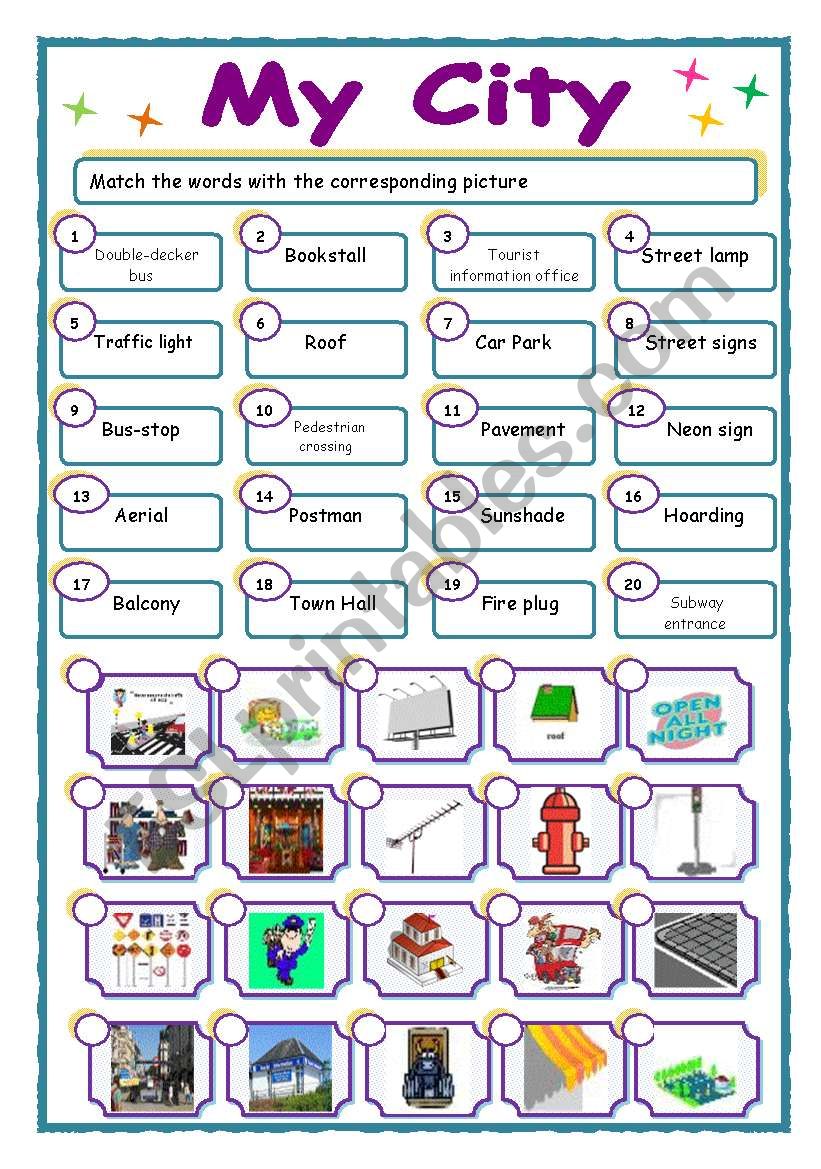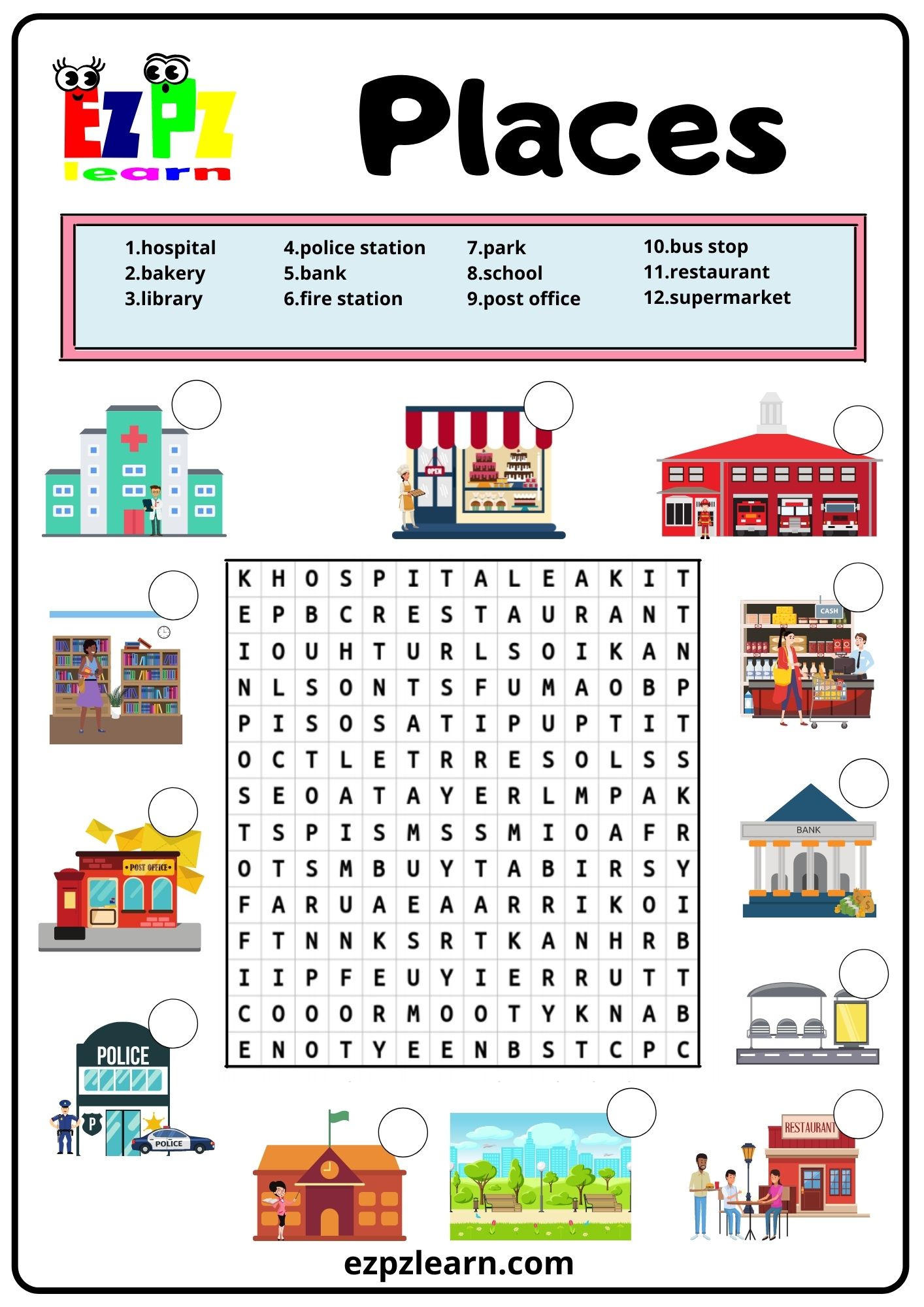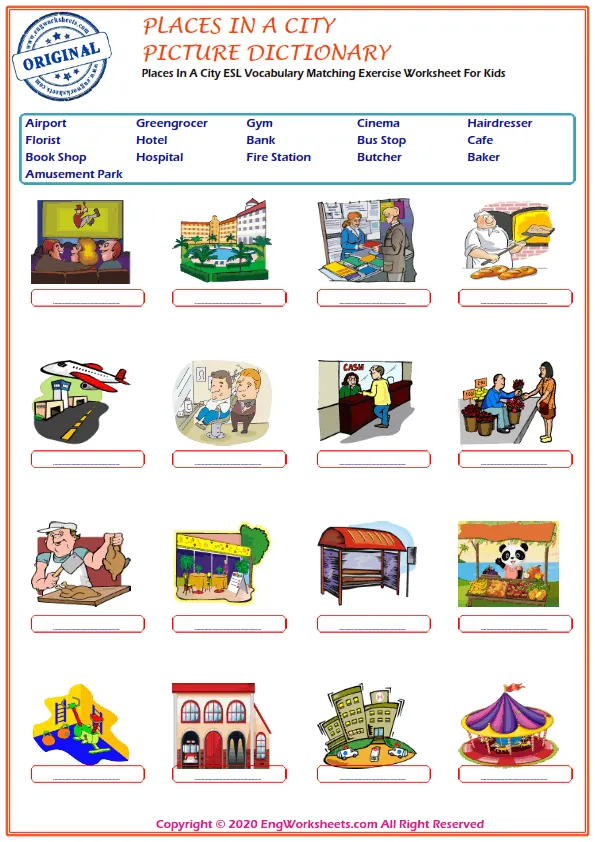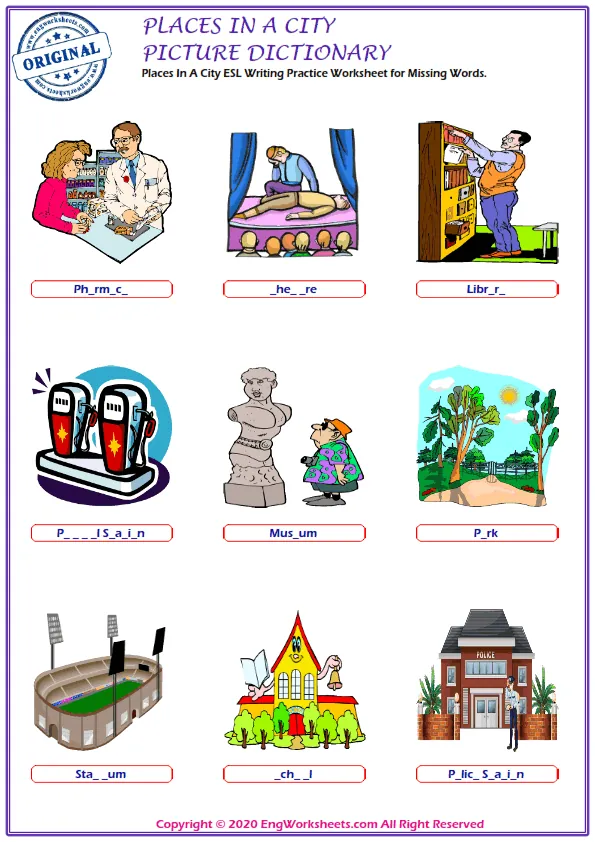
Mastering Urban Lexicon: The Indispensable Role of City Vocabulary Worksheets
The modern world is increasingly urbanized. From bustling metropolises to charming small towns, cities are vibrant hubs of human activity, culture, and commerce. For anyone navigating this urban landscape, whether as a resident, a tourist, or a language learner, a robust understanding of city-related vocabulary is not just beneficial—it’s essential. It empowers effective communication, facilitates exploration, and deepens cultural understanding. This is where city vocabulary worksheets emerge as an invaluable pedagogical tool, offering structured, engaging, and comprehensive pathways to acquiring the language of the urban environment.
This article will delve into the multifaceted importance of city vocabulary, explore what constitutes effective city vocabulary worksheets, detail various types of vocabulary and corresponding worksheet ideas, discuss the principles of designing and implementing these resources, and ultimately highlight their immense benefits for learners of all ages and proficiency levels.
The Significance of City Vocabulary

Before diving into the specifics of worksheets, it’s crucial to appreciate why city vocabulary holds such a pivotal position in language learning:

-

Practical Communication: Imagine trying to ask for directions to the nearest subway station, order food at a local restaurant, find a pharmacy, or report a lost item to the police, all without the necessary vocabulary. City vocabulary is the bedrock of daily interactions and navigation within an urban setting. Words like "street," "avenue," "intersection," "bus stop," "train station," "supermarket," "bank," "hospital," and "museum" are not just academic terms; they are functional tools for survival and convenience.

-
Cultural Immersion and Understanding: Cities are microcosms of culture. Understanding vocabulary related to historical landmarks, local government, public services, entertainment venues, and community spaces allows individuals to engage more deeply with the local culture, participate in civic life, and appreciate the nuances of urban living.
-

Cognitive Development: Learning city vocabulary involves more than just memorizing words. It often requires understanding spatial relationships (e.g., "across from," "next to," "between"), social roles (e.g., "pedestrian," "commuter," "mayor"), and the functions of various urban institutions. This process stimulates critical thinking and builds a more complex mental map of the world.
-
Academic and Professional Relevance: For students, city vocabulary frequently appears in reading comprehension passages, geography lessons, and social studies curricula. For professionals, particularly those in tourism, hospitality, urban planning, or international business, a precise vocabulary related to city infrastructure, amenities, and demographics is indispensable.




What Makes Effective City Vocabulary Worksheets?
Not all worksheets are created equal. Effective city vocabulary worksheets are designed with pedagogical principles in mind, ensuring they are not just busywork but genuine learning instruments. Here are key characteristics:
-
Variety of Exercise Types: Monotony can lead to disengagement. Good worksheets incorporate a mix of activities such as:
- Matching: Words to pictures, words to definitions, or words to synonyms/antonyms.
- Fill-in-the-Blank: Using context clues to complete sentences with appropriate vocabulary.
- Crosswords/Word Searches: Fun ways to reinforce spelling and recognition.
- True/False or Multiple Choice: Testing comprehension and differentiation.
- Picture Labeling: Ideal for visual learners, connecting words directly to images of city elements (e.g., labeling parts of a street, different buildings).
- Sentence Construction/Story Writing: Encouraging learners to use new vocabulary in context, promoting creative and productive skills.
- Role-Play Prompts: Scenarios like asking for directions, ordering food, or buying tickets.
-
Authenticity and Relevance: The vocabulary presented should be genuinely useful and reflect real-world scenarios. Worksheets that use realistic dialogues, maps, or photos make the learning more relatable and practical.
-
Gradual Progression: Worksheets should cater to different proficiency levels, starting with basic, high-frequency words for beginners and moving to more nuanced and specialized vocabulary for intermediate and advanced learners.
-
Engaging Visuals: Given the visual nature of cities, incorporating clear, appealing images, maps, and diagrams significantly enhances understanding and retention, especially for younger learners or visual learners.
-
Clear Instructions and Answer Keys: Learners should easily understand what is expected of them. Providing answer keys allows for self-correction and independent learning, fostering autonomy.
Types of City Vocabulary and Worksheet Ideas
City vocabulary can be broadly categorized, offering diverse avenues for worksheet creation:
1. Places and Buildings:
- Vocabulary: Park, library, museum, hospital, police station, fire station, school, office building, restaurant, café, supermarket, bank, post office, train station, bus stop, airport, theatre, cinema, hotel, apartment building, church, mosque, temple, synagogue, university, city hall, courthouse, monument, bridge, fountain, square, alley, sidewalk/pavement, crosswalk/zebra crossing.
- Worksheet Ideas:
- Map Labeling: Provide a simple city map and have learners label various buildings and places.
- "Where Is It?" Game: Write descriptions of places (e.g., "You go here to borrow books") and have learners match them to the correct building name.
- Category Sorting: Sort words into categories like "Public Services," "Entertainment," "Shopping," "Residential."
- Matching Pictures to Words: A classic for visual learners.
2. Transportation:
- Vocabulary: Bus, car, taxi, train, subway/metro, bicycle, motorcycle, pedestrian, traffic light, crosswalk, sidewalk, road, street, avenue, boulevard, highway, roundabout, parking lot, station, stop, fare, ticket, driver, passenger, commute.
- Worksheet Ideas:
- "How Do I Get There?" Scenarios: Provide a starting point and a destination, and have learners write directions using transportation vocabulary.
- Transportation Bingo: Call out words, and learners mark them on their cards.
- Verbs of Movement: Fill-in-the-blank sentences using verbs like "drive," "ride," "walk," "commute," "take."
- Picture Descriptions: Describe a scene with various forms of transportation, asking learners to identify them.
3. People and Professions:
- Vocabulary: Pedestrian, tourist, resident, mayor, police officer, firefighter, doctor, nurse, teacher, shop assistant, chef, waiter/waitress, bus driver, taxi driver, sanitation worker, architect, urban planner, street vendor.
- Worksheet Ideas:
- "Who Am I?" Riddles: Describe a profession (e.g., "I help people when they are sick") and have learners guess the person.
- Matching Professions to Places: Match "police officer" to "police station," "librarian" to "library."
- Role-Play Prompts: Create simple dialogues for learners to practice interaction (e.g., a tourist asking a resident for help).
4. Actions and Verbs:
- Vocabulary: Commute, explore, shop, eat out, visit, walk, drive, ride, cross, wait, ask for directions, navigate, observe, build, construct, renovate, demolish, manage.
- Worksheet Ideas:
- Sentence Completion: Provide a subject and a context, and learners complete the sentence with an appropriate verb (e.g., "Every morning, I __ to work by train.").
- Verb Tense Practice: Use city-related scenarios to practice past, present, and future tenses.
- Action Pictionary: Draw actions related to city life for others to guess.
5. Adjectives and Descriptions:
- Vocabulary: Bustling, quiet, modern, historic, crowded, spacious, tall, short, busy, peaceful, vibrant, noisy, clean, dirty, safe, dangerous, central, suburban, urban, charming, industrial.
- Worksheet Ideas:
- "Describe the City" Exercise: Show pictures of different cities or parts of a city and have learners use adjectives to describe them.
- Opposites/Synonyms: Match adjectives to their antonyms or synonyms.
- Sentence Expansion: Start with a simple sentence (e.g., "The street is long") and have learners add descriptive adjectives (e.g., "The bustling, historic street is remarkably long.").
6. Common Phrases and Expressions:
- Vocabulary: "Where is the…?," "How do I get to…?," "Can you recommend…?," "Is it far?," "What’s the fare?," "Excuse me," "Thank you," "Go straight," "Turn left/right," "It’s on your left/right," "Across from," "Next to," "Between," "Behind," "In front of."
- Worksheet Ideas:
- Dialogue Completion: Provide incomplete dialogues for learners to fill in with appropriate phrases.
- Situational Prompts: Give a scenario (e.g., "You are lost and need to find the museum") and have learners write a short conversation.
- Matching Questions to Answers: Match common city-related questions to their logical answers.
Designing and Implementing City Vocabulary Worksheets
Creating and using city vocabulary worksheets effectively requires thoughtful planning:
-
Needs Assessment: Before designing, consider the learners’ age, current proficiency level, learning styles, and specific learning objectives. A worksheet for young children will look very different from one for adult ESL learners.
-
Integration with Other Skills: Vocabulary should not be learned in isolation. Design worksheets that encourage learners to read, listen, speak, and write using the new words. For example, a worksheet could include a short audio clip of a conversation in a city setting, followed by comprehension questions and a writing task using the vocabulary.
-
Utilizing Technology: Leverage online tools and platforms. Many websites offer interactive worksheet generators, digital flashcards, and online quizzes. Interactive PDFs can also make traditional worksheets more dynamic.
-
Differentiation: Provide options for learners of varying abilities. This could mean offering simpler versions of tasks for struggling learners or more complex, open-ended activities for advanced students.
-
Feedback and Assessment: Incorporate mechanisms for learners to receive feedback on their work. This could be self-correction with an answer key, peer correction, or teacher feedback. Worksheets can also serve as informal assessment tools to gauge vocabulary acquisition.
-
Making it Fun and Interactive: Incorporate games, puzzles, and collaborative activities. Turn a simple matching exercise into a race, or a sentence-building task into a group story. The more enjoyable the experience, the more effective the learning.
The Benefits of Using City Vocabulary Worksheets
The widespread adoption of city vocabulary worksheets in language education is a testament to their numerous benefits:
- Reinforces Learning: Repetition and varied practice, characteristic of well-designed worksheets, significantly aid memory retention.
- Provides Structured Practice: Worksheets offer a clear, systematic way for learners to engage with new vocabulary, guiding them through different types of exercises.
- Builds Confidence: Successfully completing a worksheet provides a sense of accomplishment, encouraging learners to tackle more complex language tasks.
- Facilitates Independent Learning: With clear instructions and answer keys, learners can work at their own pace, fostering autonomy and self-directed study.
- Saves Teacher Preparation Time: While creating worksheets takes time, well-designed, reusable ones can significantly reduce daily lesson planning, allowing educators to focus on more interactive and communicative activities.
- Tangible Progress: Worksheets provide a tangible record of learning, allowing both learners and educators to see progress over time.
Conclusion
In an increasingly interconnected and urbanized world, the ability to communicate effectively about cities is paramount. City vocabulary worksheets are far more than mere supplementary materials; they are foundational tools that bridge the gap between theoretical language knowledge and practical application. By offering diverse, engaging, and systematically structured practice, these worksheets empower learners to master the lexicon of urban life, transforming them from passive observers into confident, articulate participants in the city’s dynamic narrative. For educators, they are indispensable resources for creating effective and enjoyable language learning experiences, ensuring that students are well-equipped to navigate, understand, and thrive in the vibrant tapestry of the world’s cities.
